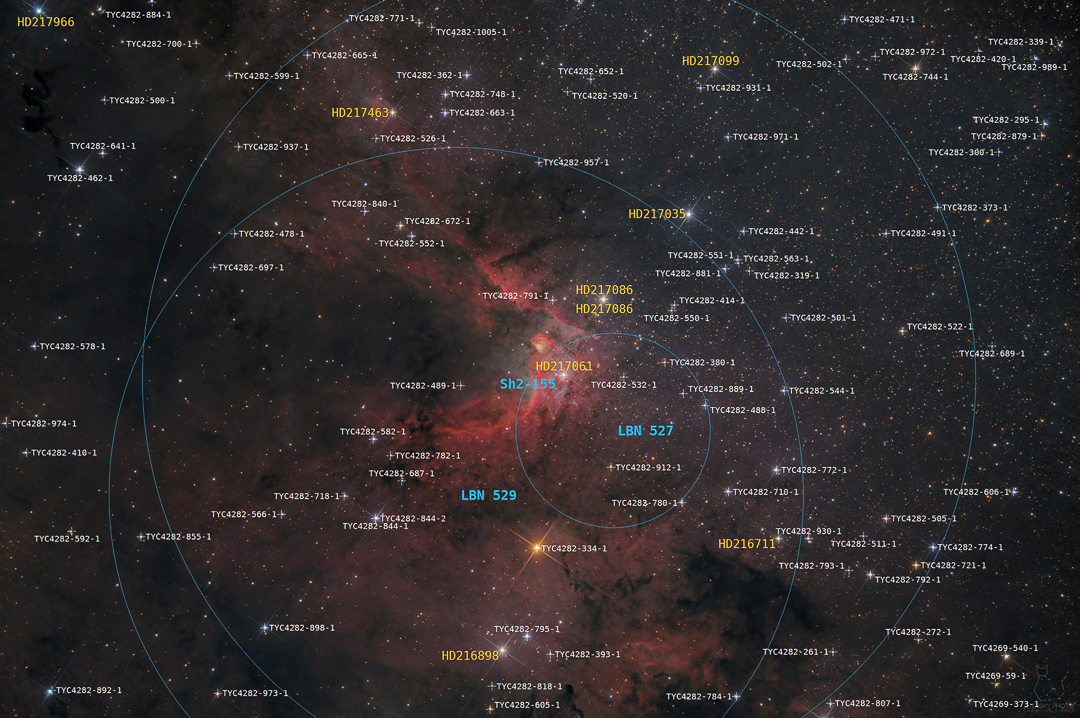Emission Nebula in constellation “Cepheus”
![]() 16.05.2023 – “Top Pick Nomination” on Astrobin
16.05.2023 – “Top Pick Nomination” on Astrobin
Project #8
SH2-155 – Object Description
Sh2-155 (also designated Caldwell 9, Sharpless 155 or S155) is a diffuse nebula in the constellation Cepheus, within a larger nebula complex containing emission, reflection, and dark nebulosity. It is widely known as the Cave Nebula, though that name was applied earlier to Ced 201, a different nebula in Cepheus.
Sh2-155 is an ionized H II region with ongoing star formation activity, at an estimated distance of 725 parsecs (2400 light-years) from Earth. Sh2-155 was first noted as a galactic emission nebula in 1959 in the extended second edition of the Sharpless catalogue, being a part of the much larger Cep OB3 Association. Although Sh2-155 is relatively faint for amateur observation, some of its structure may be seen visually through a moderately sized telescope under dark skies.
Sh2-155 lies at the edge of the Cepheus B cloud (part of the Cepheus molecular cloud), and is ionized by young stars from the Cep OB3 association. It has been suggested that radiation from the hot O-type star HD 217086 is compressing the region, triggering the formation of a new generation of stars. A study of the region’s young stellar objects by the Chandra X-ray Observatory and Spitzer Space Telescope shows a progression of stellar ages in front of the cloud, supporting the hypothesis of triggered star-formation. (Source: Wikipedia)
SH2-155 – Project Publications
Image Publications
Please find all project-related images for this revision below.
SH2-155 – Project Details
Please find all project-related details for this revision below.
There is a first revision for SH2-155.
If you like, here’s a great Youtube-Tutorial of my friend Daniel Nimmervoll where he shows his latest processing workflow.
| Astrobin Link | SH2-155 / Cave Nebula (Rev.2) with OSC |
| Further Publications | spektrum.de – SH2-155 Cave Nebula |
| Astronomical Object | SH2-155 / Caldwell 9 |
| Distance to Earth | 2.400 light years |
| Size / Diameter | 70 light years |
| Date(s) of Photography | November 2022 |
| Exposure Details | Clearglass: 168 x 180″ (8h 24min) Total: 8h 24min |
| Calibration | FlatsA "flat frame" is shot against a bright surface and contains vignetting and all the "bad" things (e.g. dust particles) that block/disturb your light train. The combination/stack of multiple flat frames is called a "Master Flat". More: 50 BIAS: 50 Master-Dark |
| Equipment | Mount: Skywatcher EQ6-R PRO (the old w/o USB-interface) Telescope: Skywatcher 200PDS Newton (200mm/1000mm, f/5) Camera: Touptek DeepSky Pro 2600c (Gain: 100, Offset: 100) Clearglass Filter: Baader Clearglass 2″ Dual Narrowband Filter: Optolong L-eXtreme 2″ Corrector: Pál Gyulai GPU Komakorrektor Guiding(Auto-)Guiding is essential in astrophotography, as an un-guided mount/telescope will produce blurry images as the stars / the deepsky object will drift away. This is heavily dependent on the exposure time, so for long exposures you want to make sure to have a perfectly set up auto-guiding. More: ZWO ASI120MM + 50mm Helical GuideScope |
| Software | Observatory Automation: Sequence Generator Pro Guiding(Auto-)Guiding is essential in astrophotography, as an un-guided mount/telescope will produce blurry images as the stars / the deepsky object will drift away. This is heavily dependent on the exposure time, so for long exposures you want to make sure to have a perfectly set up auto-guiding. More: PHD Post-Processing: Astro Pixel Processor + PixInsight + Photoshop |


